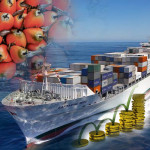‘Traffic Light’ Nutrition Labelling Scheme: Implications for Palm Oil
Governments have grown increasingly worried about consumers’ dietary habits, and how these relate to the prevalence of obesity and other non-communicable diseases. All sorts of policies are in place to educate consumers on the importance of a balanced diet and adequate physical activity.
Although there appears to be relative consensus on this idea, authorities in different countries openly disagree on the means to achieve it. The ‘traffic light’ nutrition labelling scheme best illustrates this. Such labels are usually placed on the front-of-pack of pre-packed foods and use a colour-based code (normally, red, amber and green) to inform consumers on the amounts of certain nutrients.
Supporters claim that there are numerous studies suggesting that, where the front-of-pack provides information on nutritional quality, consumers are more likely to base their choices on such information and, ultimately, to choose healthier foods.
It is argued that today’s hectic lifestyle does not allow the average consumer to devote as much time as desired to carefully read food labels; and that ‘traffic light’ labelling facilitates the task and reduces the amount of time necessary to understand nutritional properties.
Detractors argue that it is overly simplistic and they question its supposedly positive effects. In addition, they claim that this scheme unfairly punishes specific foods and that it could even result in counter-productive effects in the long run.
Indeed, the vast majority of pre-packed foods have complex nutritional properties and it may be difficult to translate their fat, sugar and salt (to name a few) content into single colours. This extreme simplification is likely to sacrifice a level of detail that is, nevertheless, necessary for consumers to fully assess the nutritional adequacy of a given food product.
In addition, ‘traffic light’ labelling schemes focus on the nutritional adequacy of specific products, while entirely disregarding the broader dietary context in which they are consumed.
Some pre-packed foods may be high in fats and contribute to high calorie intake, but that does not mean that they should be completely excluded from the diet. On the contrary, they have their place in every balanced and healthy diet, when consumed in the right amounts, in the indicated frequency and in combination with the right nutrients.
In addition, ‘traffic light’ nutritional labelling schemes punish specific ingredients, such as those from dairy origin or vegetable oils, which stand to be negatively marked regardless of their many positive features. Rightly, ‘traffic light’ schemes are a concern for the palm oil industry.
Impact on palm oil
Palm oil is a naturally stable fat made up of saturated and unsaturated fatty acids, well endowed with saturated palmitic and monounsaturated oleic acids, as well as polyunsaturated linoleic acid. This combination provides an almost ideal mix for the preparation of solid and semi-solid formulations likely to be marketed as pre-packed foods that will have a long shelf-life.
As a result of its semi-solid state at room temperature, palm oil does not require to undergo the process of hydrogenation for most food uses. This makes it free from trans fats, which have harmful effects on health – such as increasing low-density lipoprotein (‘bad’) cholesterol and decreasing high-density lipoprotein (‘good’) cholesterol in the blood. Palm oil also contains beta carotene and Vitamin E tocotrienols with cholesterol-lowering and antioxidant properties.
Paradoxically, and despite the complex and nutritionally rich profile of palm oil, it is unlikely to pass the examination imposed by the reductionist and arbitrary standards of ‘traffic light’ nutrition labelling schemes. These would likely label palm oil at the same level as any other ‘vulgar’ fat, by focusing solely on the (probably) high fat and calorie content of the food product at hand.
Stance in UK and France
This flagrant evidence has not stopped certain member-states of the EU – which is a scenario of the debate between ‘for’ and ‘against’ ‘traffic light’ nutrition labelling schemes – from considering and even adopting this type of schemes.
In June 2013, the UK issued a set of guidelines to be applied in cases where operators decide to use colour-coding as an additional form of expression on front-of-pack nutrition labels, as recommended by its Health Ministry and Food Standards Agency. Therefore, although resort to colour-coding remains voluntary in the country, operators need to abide by the government’s guidelines if they wish to put it in practice.
The issuance of these guidelines sparked concerns that national guidelines would create barriers in the EU. At first, the European Commission (EC) highlighted the scheme’s voluntary character and stated that it did not share such concerns. But as the effects became more self-evident, the EC expressed reservations; it eventually initiated infringement proceedings in October 2014 by sending a letter of formal notice to the UK.
Another jurisdiction that appears to persist in its intentions is France. The draft Public Health Act, which (at the time of writing) is being discussed at the Parliament, foresees the use of a voluntary colour-based nutrition labelling scheme whereby operators that wish to adopt the scheme need to do so in accordance with requirements in the law.
In particular, the draft foresees that calories, fat, saturated fats, sugar and salt (and, in some other cases, also fibre, fruits, nuts, proteins and vegetables) be reflected on the front-of-pack by means of a five-point scale with either green, yellow, orange, pink or red dots. It remains to be seen whether the scheme will be implemented as it stands, or whether the draft will be amended.
Are ‘traffic light’ schemes legal?
Legislation in place in the EU does not prohibit this type of schemes, but it but lays down requirements to ensure (inter alia) that, where they are used, they are provided in addition to (and not instead of) mandatory nutritional information, and that they do not compromise such mandatory labelling.
Although any legal assessment of ‘traffic light’ nutrition schemes may be general and premature, there are a number of aspects that, in the context of a legal examination against EU law, may be problematic.
- First, any ‘traffic light’ or similar nutrition labelling scheme needs to remain, both in theory and in practice, voluntary. Instances where government agencies recommend the use of the scheme, or cases where food retailers (or food manufacturers) are de facto compelled to use the scheme, may compromise the requirement that it be voluntary.
- Second, in order to be permitted, the scheme must be ‘beneficial’. However, it is questionable whether food packages with a majority of red dots on the front-of-pack (where there is a societal agreement that red means ‘stop’ and green means ‘go’) could still be considered ‘beneficial’.
- Finally, these schemes must not pose barriers to the free movement of goods within the EU market, which may be questioned if schemes of this type proliferate at the national level in selected member-states.
Clearly, regardless of the good-faith intentions to provide information to consumers, so that they can make informed dietary choices and ultimately reduce the prevalence of obesity and of other non-communicable diseases among the population, ‘traffic light’ nutrition labelling schemes are far from being an ideal instrument.
On the contrary, their limited accuracy and the problems arising from giving only partial and overly-simplified information to consumers may be detrimental and even counter-productive in the long term.
Against this background, governments and their agencies should explore alternative policy options. Enhanced food education programmes at school and publicly-funded service adverts, for instance, constitute examples of policy instruments that do not compromise the policy’s aim nor consumers’ right to accurate and comprehensive information.
Ultimately, what needs to be borne in mind is that there are no good foods or bad foods, but only good or bad dietary habits.
Fratini Vergano
European Lawyers










Leave a Reply